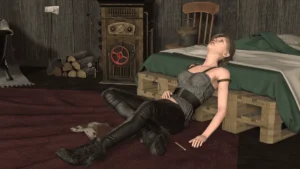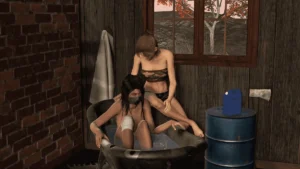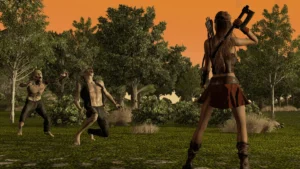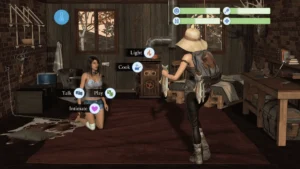
Teen Zombie in Your Cabin
Play Teen Zombie in Your Cabin
Teen Zombie in Your Cabin review
Master survival, relationships, and moral choices in this unique post-apocalyptic experience
Teen Zombie in Your Cabin stands out as a distinctive post-apocalyptic survival simulation that blends resource management with emotional roleplay elements. Set three years after a zombie outbreak, you find yourself alone in an isolated woodland cabin until you encounter a young zombie who appears different from the undead hordes. This game challenges players to balance survival instincts with compassion, offering a thought-provoking narrative where your decisions shape both the zombie’s humanity and your own moral compass. Whether you’re drawn to complex storytelling, strategic resource management, or exploring the boundaries of human connection in a broken world, this interactive experience delivers a uniquely engaging adventure that goes beyond traditional zombie narratives.
Gameplay Mechanics and Core Systems
Understanding Resource Management and Survival
Let me paint you a picture of my first week with Teen Zombie in Your Cabin gameplay. I was so focused on teaching my new companion how to brush her teeth that I completely forgot to go hunting. The result? A very cold, very hungry, and very grumpy teen zombie who then refused to participate in any more lessons. I learned the hard way that in this post-apocalyptic cabin survival experience, everything is connected. 🏚️
The core of this survival resource management zombie game revolves around three pillars: food, warmth, and safety. You’re not just managing these for yourself, but for two. Your cabin is your sanctuary, but it’s a constant battle against the elements and decay.
Pro Tip: Always prioritize securing a steady food source before winter hits. A starving zombie is an uncooperative zombie, and you’ll lose precious days of progress.
Here’s a breakdown of the primary resources you’ll be juggling:
| Resource | Mechanics | Player Impact |
|---|---|---|
| Fresh Meat | Hunting via mini-games; can be preserved with salt or smoking. | Directly affects the zombie’s mood, health, and willingness to learn. A diet of only canned food leads to lethargy. |
| Cabin Warmth | Maintained by repairing windows, chopping wood for the stove, and crafting insulation. | Prevents illness for both you and your charge. A cold cabin can trigger negative memories and regressive behavior. |
| Medical Supplies | Scavenged from abandoned houses or traded with rare friendly survivors. | Used to treat injuries from hunts or… incidents. Crucial for maintaining trust during violent relapses. |
| Sanity & Comfort | Maintained through personal activities like reading, brewing tea, or tidying the cabin. | Your mental state influences your dialogue options and decision-making speed. A stressed caretaker makes rash choices. |
The beauty of this system is its fragility. A single heavy snowstorm can trap you inside for days, burning through your woodpile and forcing you to make tough calls about rationing. Faction raids are the ultimate test of your survival resource management zombie game skills—do you use your precious bullets to defend your home, or hope they pass by? These procedural events ensure that no two playthroughs of this interactive decision-making game are ever the same. Every day is a new puzzle. 🧩
Teaching and Rehabilitation Mechanics
This is where Teen Zombie in Your Cabin truly shines and separates itself from any other game you’ve played. The character development and rehabilitation system isn’t just a menu; it’s a series of intimate, sometimes heartbreaking interactions. You’re not training a pet; you’re gently guiding a person back to themselves.
I remember the first time she successfully identified a “friend” from a “foe” flashcard without growling. It felt like a genuine victory. The relationship system mechanics are woven directly into these teaching moments.
The core activities are deceptively simple but carry immense emotional weight:
- Flashcard Minigames 🃏: You’ll use these to rebuild core vocabulary and concepts. Start with simple nouns (“apple,” “book”) and progress to complex emotions and social cues. Her mood directly affects her performance here.
- Social Scenario Roleplay 🎭: This is advanced training. You act out encounters she might have, teaching her how to respond to a greeting or a threat. Getting these right is crucial if you ever want to reintroduce her to other people.
- Hygiene Routines 🪥: Something as simple as brushing teeth becomes a profound act of care. It’s a daily ritual that reinforces routine, safety, and self-worth. Neglecting it doesn’t just make her dirty; it makes her feel less human.
The relationship system mechanics are a delicate dance. Her mood isn’t just a meter; it’s a living, reactive state. Did you serve her fresh rabbit stew? +Mood. Did you have to leave her alone for too long while scavenging? -Mood. Did you raise your voice in frustration during a lesson? That could lead to a full-scale withdrawal for the rest of the day. You learn to read her body language—a slight hunch of the shoulders, the way she looks at her hands, a low hum when she’s content. This deep, non-verbal communication is the heart of the character development and rehabilitation process. You’re building trust, one small, consistent action at a time. ❤️
Decision-Making and Moral Consequences
Welcome to the emotional core of the Teen Zombie in Your Cabin gameplay—the part that will have you pausing the game, putting the controller down, and staring at the ceiling. The moral choice consequences in this game are not about being a “good” or “bad” person. They are about survival, love, and the terrifying weight of responsibility.
The game constantly presents you with interactive decision-making game dilemmas where there is no clear right answer. The most defining choices revolve around her “episodes”—those terrifying moments when the infection flares up and the person you know vanishes, replaced by something primal and dangerous.
Let’s walk through a real scenario I faced, which perfectly illustrates the branching moral choice consequences.
The Scenario: After a particularly stressful day where a scavenger got too close to the cabin, my teen zombie had a violent relapse, destroying a good portion of our medical supplies. I managed to calm her down, and she’s now sleeping, looking peaceful and utterly vulnerable.
The Choice:
* Option A: Hide the Evidence. Bury the broken supplies, tell any inquiring survivors it was an animal attack. Project an image of control.
* Option B: Seek Help. Travel to the nearest enclave, confess what happened, and ask for their assistance, knowing they are deeply fearful of the infected.
The Branches:
If you choose to HIDE THE EVIDENCE:
This maintains the fragile peace in the short term. Your companion never knows you covered for her, which preserves her trust in you. However, you’ve now sown seeds of distrust with the outside world. When a doctor from the enclave later offers an experimental cure, they may be less willing to give it to you, suspecting you’re not being entirely truthful. This path often leads to an isolated ending, where your secret becomes a wall between you and the rest of humanity. You’ve chosen your cabin mate over everyone else.If you choose to SEEK HELP:
This is the high-risk, high-reward path. The enclave might be sympathetic, offering you sedatives or even a therapist’s guidance. This can unlock new, positive dialogue options and accelerate character development and rehabilitation. However, they might also decide your companion is too great a risk. The moral choice consequences here could be immediate and severe: they might demand you hand her over for “containment” or exile you both from the area, forcing you to become nomads in a hostile world.
This is just one example! The game is filled with these moments. Do you use a precious antibiotic on her wound or save it for yourself in case you get sick? Do you tell her the truth about her family, potentially triggering a major setback, or let her remember in her own time? Every choice, from the monumental to the mundane, feeds into the narrative algorithm, steering you toward one of the multiple endings.
These endings are the final, powerful expression of the Teen Zombie in Your Cabin experience. Will you achieve a bittersweet cohabitation, having created a new kind of family in the ruins? Will you risk it all on an untested cure? Or will you, in the final hours, decide that the world isn’t ready for your miracle, choosing to flee civilization forever, just the two of you against the wild? The path is yours to walk, and every step matters. 🌲✨
Teen Zombie in Your Cabin delivers a uniquely compelling experience that transcends typical zombie game conventions. By combining survival mechanics with genuine emotional storytelling, the game creates a space where players confront meaningful moral questions while building an unlikely bond with a character who challenges everything they thought they knew about humanity and compassion. The intricate relationship system, atmospheric design, and branching narrative structure ensure that each playthrough feels fresh and consequential. Whether you’re drawn to the strategic resource management, the mystery surrounding the zombie’s origins, or the philosophical questions about what it means to remain human in a broken world, this game offers depth that rewards exploration and reflection. The multiple endings and hidden lore elements provide substantial replay value, inviting players to discover new facets of the story with each journey. For those seeking a mature, thought-provoking interactive experience that balances challenge with emotional resonance, Teen Zombie in Your Cabin stands as a distinctive entry in the post-apocalyptic genre that lingers long after the credits roll.










